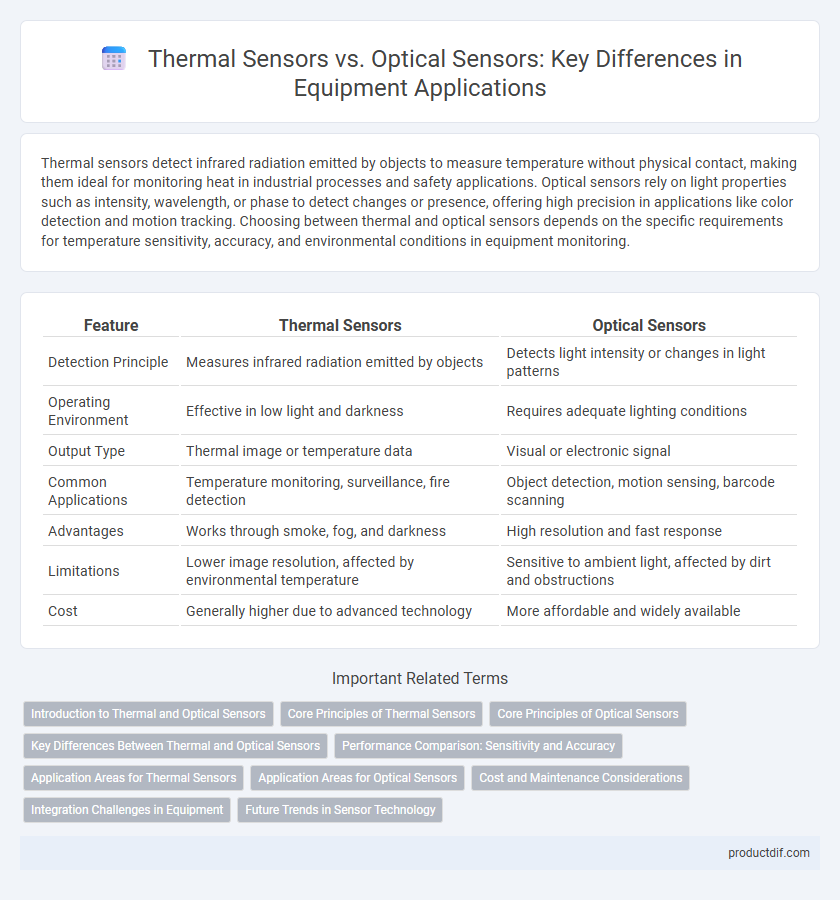Thermal sensors detect infrared radiation emitted by objects to measure temperature without physical contact, making them ideal for monitoring heat in industrial processes and safety applications. Optical sensors rely on light properties such as intensity, wavelength, or phase to detect changes or presence, offering high precision in applications like color detection and motion tracking. Choosing between thermal and optical sensors depends on the specific requirements for temperature sensitivity, accuracy, and environmental conditions in equipment monitoring.
Table of Comparison
| Feature | Thermal Sensors | Optical Sensors |
|---|---|---|
| Detection Principle | Measures infrared radiation emitted by objects | Detects light intensity or changes in light patterns |
| Operating Environment | Effective in low light and darkness | Requires adequate lighting conditions |
| Output Type | Thermal image or temperature data | Visual or electronic signal |
| Common Applications | Temperature monitoring, surveillance, fire detection | Object detection, motion sensing, barcode scanning |
| Advantages | Works through smoke, fog, and darkness | High resolution and fast response |
| Limitations | Lower image resolution, affected by environmental temperature | Sensitive to ambient light, affected by dirt and obstructions |
| Cost | Generally higher due to advanced technology | More affordable and widely available |
Introduction to Thermal and Optical Sensors
Thermal sensors detect infrared radiation emitted by objects, enabling temperature measurement without direct contact and are widely used in industrial monitoring and medical diagnostics. Optical sensors operate by detecting light intensity, color, or changes in light properties, often utilized in applications like motion detection, proximity sensing, and environmental monitoring. Both sensor types offer critical advantages, with thermal sensors excelling in low-visibility conditions and optical sensors providing high precision in light-based measurements.
Core Principles of Thermal Sensors
Thermal sensors operate based on the principle of detecting infrared radiation emitted by objects, which correlates with their temperature. These sensors utilize thermopiles or pyroelectric materials to measure temperature gradients without direct contact. Unlike optical sensors that rely on visible light detection, thermal sensors provide accurate temperature readings in complete darkness or through smoke and dust.
Core Principles of Optical Sensors
Optical sensors operate on the core principle of detecting changes in light properties such as intensity, wavelength, or phase when interacting with an object or environment. These sensors convert light signals into electrical signals using photodetectors, enabling precise measurement of distance, motion, or surface characteristics. Unlike thermal sensors that rely on temperature variations, optical sensors provide faster response times and higher sensitivity in applications like industrial automation and environmental monitoring.
Key Differences Between Thermal and Optical Sensors
Thermal sensors detect infrared radiation emitted by objects to measure temperature variations, while optical sensors rely on visible or near-visible light to capture images or detect light intensity changes. Thermal sensors excel in low-light or obscured environments by sensing heat signatures, making them ideal for night vision and temperature monitoring, whereas optical sensors provide higher-resolution data suitable for color imaging and detailed visual analysis. The core difference lies in the type of energy detected--thermal sensors sense radiated heat, whereas optical sensors measure reflected or emitted light.
Performance Comparison: Sensitivity and Accuracy
Thermal sensors detect infrared radiation emitted by objects, offering high sensitivity to temperature variations, which allows precise measurement in environments with fluctuating thermal conditions. Optical sensors rely on light detection, providing superior accuracy in capturing spatial details and color changes but may be affected by ambient light interference. Overall, thermal sensors excel in temperature sensitivity, whereas optical sensors deliver higher spatial resolution and accuracy in visual data acquisition.
Application Areas for Thermal Sensors
Thermal sensors excel in industrial equipment monitoring, detecting heat variations to prevent overheating and ensure operational safety. They are crucial in HVAC systems for precise temperature regulation and energy efficiency improvements. These sensors also play a vital role in medical devices for patient temperature tracking and in firefighting equipment to identify hotspots and fire outbreaks quickly.
Application Areas for Optical Sensors
Optical sensors are widely used in industrial automation, robotics, and healthcare for precise measurement and detection of light, color, and movement. They excel in applications such as barcode scanning, fiber optic communication, and non-contact temperature measurement, offering high sensitivity and fast response times. Their ability to detect changes in light intensity and wavelength makes them essential for process control, environmental monitoring, and quality inspection systems.
Cost and Maintenance Considerations
Thermal sensors typically have higher initial costs but lower maintenance requirements due to fewer moving parts and less susceptibility to environmental contamination. Optical sensors generally offer lower upfront prices but may incur increased maintenance expenses because of lens cleaning, alignment calibration, and sensitivity to dust or moisture. Evaluating total cost of ownership over time reveals thermal sensors can be more cost-effective in harsh or industrial settings, while optical sensors suit controlled environments with budget constraints.
Integration Challenges in Equipment
Thermal sensors often face integration challenges in equipment due to their sensitivity to ambient temperature fluctuations and the need for precise calibration to ensure accurate readings. Optical sensors demand careful alignment and can be affected by dust, vibrations, or ambient light interference, complicating seamless integration. Both sensor types require customized mounting solutions and signal processing adjustments to maintain system reliability and performance.
Future Trends in Sensor Technology
Thermal sensors are advancing with enhanced sensitivity and integration of AI algorithms for real-time temperature analytics, boosting efficiency in industrial automation and environmental monitoring. Optical sensors are evolving through miniaturization and improvements in light detection accuracy, enabling applications in autonomous vehicles and medical diagnostics. Future trends indicate a convergence of thermal and optical sensor technologies to create hybrid systems offering comprehensive sensing capabilities and improved performance across diverse sectors.
Thermal sensors vs Optical sensors Infographic

 productdif.com
productdif.com